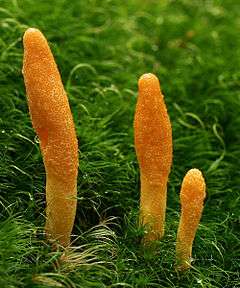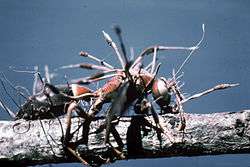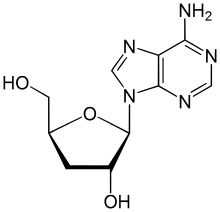Cordyceps
| Cordyceps | |
|---|---|
 | |
| Cordyceps militaris | |
| Scientific classification | |
| Kingdom: | Fungi |
| Division: | Ascomycota |
| Class: | Sordariomycetes |
| Order: | Hypocreales |
| Family: | Cordycipitaceae |
| Genus: | Cordyceps Fr. (1818) |
| Type species | |
| Cordyceps militaris (L.) Fr. (1818) | |
| Species | |
|
about 400 | |
Cordyceps /ˈkɔːrdɪsɛps/ is a genus of ascomycete fungi (sac fungi) that includes about 400 species. Most Cordyceps species are endoparasitoids, parasitic mainly on insects and other arthropods (they are thus entomopathogenic fungi); a few are parasitic on other fungi. The generic name Cordyceps is derived from the Greek word κορδύλη kordýlē, meaning "club", and the Latin stem -ceps, meaning "head".
The genus has a worldwide distribution and most of the approximately 400 species[1] have been described from Asia (notably Nepal, China, Japan, Bhutan, Korea, Vietnam, and Thailand). Cordyceps species are particularly abundant and diverse in humid temperate and tropical forests.
Species
C. sinensis was shown in 2007 by nuclear DNA sampling to be unrelated to most of the rest of the members of the genus; as a result it was renamed Ophiocordyceps sinensis and placed in a new family, the Ophiocordycipitaceae, as was "Cordyceps unilateralis".[2] Other species previously included in the genus Cordyceps have now been placed in the genus Tolypocladium.
Cordyceps and Metacordyceps spp. are now thought to be the teleomorphs of a number of anamorphic, entomopathogenic fungus "genera" such as: Beauveria (Cordyceps bassiana), Lecanicillium, Metarhizium and Nomuraea.
Biology
When a Cordyceps fungus attacks a host, the mycelium invades and eventually replaces the host tissue, while the elongated fruit body (ascocarp) may be cylindrical, branched, or of complex shape. The ascocarp bears many small, flask-shaped perithecia containing asci. These, in turn, contain thread-like ascospores, which usually break into fragments and are presumably infective.
Research
Polysaccharide components and cordycepin are under basic research and have been isolated from C. militaris.[3][4]
In popular culture
The Last of Us, a 2013 video game developed by Naughty Dog, portrays a fictional Cordyceps fungus that has mutated to infect human hosts, with apocalyptic results.[5]
Gallery
 Cordyceps beginning its growth from a wasp
Cordyceps beginning its growth from a wasp Cordyceps militaris
Cordyceps militaris Cordyceps militaris
Cordyceps militaris
References
- ↑ Sung, Gi-Ho; Nigel L. Hywel-Jones; Jae-Mo Sung; J. Jennifer Luangsa-ard; Bhushan Shrestha & Joseph W. Spatafora (2007). "Phylogenetic classification of Cordyceps and the clavicipitaceous fungi". Stud Mycol. 57 (1): 5–59. doi:10.3114/sim.2007.57.01. PMC 2104736. PMID 18490993.
- ↑ Holliday, John; Cleaver, Matt (2008). "Medicinal Value of the Caterpillar Fungi Species of the Genus Cordyceps (Fr.) Link (Ascomycetes). A Review" (PDF). International Journal of Medicinal Mushrooms. New York: Begell House. 10 (3): 219–234. doi:10.1615/IntJMedMushr.v10.i3.30. ISSN 1521-9437.
- ↑ Khan, MA; Tania, M; Zhang, D; Chen, H (May 2010). "Cordyceps Mushroom: A Potent Anticancer Nutraceutical" (PDF). The Open Nutraceuticals Journal. 3: 179–183. doi:10.2174/1876396001003010179. Archived from the original (PDF) on 18 March 2012.
- ↑ Nakamura, K; Shinozuka, K; Yoshikawa, N (2015). "Anticancer and antimetastatic effects of cordycepin, an active component of Cordyceps sinensis". Journal of Pharmacological Sciences. 127 (1): 53–6. doi:10.1016/j.jphs.2014.09.001. PMID 25704018.
- ↑ Grounded: The Making of The Last of Us. 2014-02-28. Event occurs at 13m28s.
Further reading
- Bensky, D.; Gamble, A.; Clavey, S.; Stoger, E.; Lai Bensky, L. (2004). Chinese Herbal Medicine: Materia Medica (3rd ed.). Seattle: Eastland Press. ISBN 0-939616-42-4.
- Kobayasi, Y. (1941). "The genus Cordyceps and its allies". Science Reports of the Tokyo Bunrika Daigaku, Sect. B. 5: 53–260. ISSN 0371-3547.
- Mains, E. B. (1957). "Species of Cordyceps parasitic on Elaphomyces". Bulletin of the Torrey Botanical Club. 84 (4): 243–251. doi:10.2307/2482671. ISSN 0040-9618. JSTOR 2482671.
- Mains, E. B. (1958). "North American entomogenous species of Cordyceps". Mycologia. 50 (2): 169–222. doi:10.2307/3756193. ISSN 0027-5514. JSTOR 3756193.
- Tzean, S. S.; Hsieh, L. S.; Wu, W. J. (1997). Atlas of entomopathogenic fungi from Taiwan. Taiwan: Council of Agriculture, Executive Yuan.
- Paterson, R. R. M. (2008). "Cordyceps - a traditional Chinese medicine and another fungal therapeutic biofactory?". Phytochemistry. 69 (7): 1469–1495. doi:10.1016/j.phytochem.2008.01.027. PMID 18343466.
See also
External links
| Wikimedia Commons has media related to Cordyceps. |
| Wikispecies has information related to Cordyceps |
